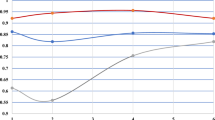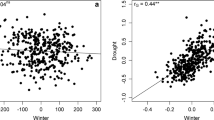Abstract
Breeding for resistance to soil-borne powdery scab in potato is an important component of the integrated management of this disease. Different genetic variance models within a mixed model framework were applied to data from long-term potato breeding trials, for the genetic evaluation of breeding lines. The multi-environment trial (MET) data came from 12 growing seasons (“years”, synonymous with environments) of New Zealand field trials screening for resistance to powdery scab on potato tubers. Pedigree information on a total of 1,031 genotypes was available. Additive components of the genetic effects were important with narrow-sense heritability estimates (and 95 % confidence intervals) from single-year analyses ranging from 0.26 (0.20, 0.44) to 0.57 (0.53, 0.85). Spatial components estimated from the residual plot effects were not important for most years and even when they were significant, estimates were small. In MET analyses, different variance structures for the genetic effects were tested; a homogeneous correlation model (CORH) gave a better fit to the data than a factor analytic FAk model of order (k), 1 and 2. The year-to-year genetic correlation estimate from CORH was 0.81 and compared with a range of 0.59–0.95 estimated from the FA1 model. There was no strong evidence of non-additive genetic effects with zero or boundary estimates for most years. Models which included the pedigree provided a better fit to the data than models that did not include this relationship information. There was no evidence for genetic improvement in resistance for powdery scab on tubers in the breeding population studied. This suggests that selection pressure for resistance in the past has been weak and greater consideration should be given to selecting parents on empirical breeding values to genetically improve breeding populations for resistance to powdery scab.






Similar content being viewed by others
References
Baldwin SJ, Genet RA, Butler RC, Jacobs JME (2008) A greenhouse assay for powdery scab (Spongospora subterranea f. sp subterranea) resistance in potato. Potato Res 51:163–173. doi:10.1007/s11540-008-9100-7
Balzarini M (2001) Applications of mixed models in plant breeding. In: Kang MS (ed) Quantitative genetics, genomics and plant breeding. CABI Publishing, Wallingford, pp 353–363
Beeck CP, Cowling WA, Smith AB, Cullis BR (2010) Analysis of yield and oil from a series of canola breeding trials. Part I. Fitting factor analytic mixed models with pedigree information. Genome 53:992–1001. doi:10.1139/g10-051
Bhattacharya SK, Sheo R, Dwivedi R (1985) Sources of resistance to powdery scab in potatoes. Indian Phytopathol 38:174–175
Burgueño J, Crossa J, Cornelius PL, Trethowan R, McLaren G, Anitha K (2007) Modeling additive × environment and additive × additive × environment using genetic covariances of relatives of wheat genotypes. Crop Sci 47:311–320. doi:10.2135/cropsci2006.09.0564
Burgueño J, Crossa J, Cotes JM, San Vicente F, Das B (2011) Prediction assessment of linear mixed models for multi-environment trials. Crop Sci 51:944–954. doi:10.2135/cropsci2010.07.0403
Burgueño J, de los Campos G, Weigel K, Crossa J (2012) Genomic prediction of breeding values when modeling genotype × environment interaction using pedigree and dense molecular markers. Crop Sci 52:707–719. doi:10.2135/cropsci2011.06.0299
Butler DG, Cullis BR, Gilmour AR, Gogel BJ (2009) ASReml-R reference manual, VSN International, Hemel Hempstead, UK. http://www.vsni.co.uk/downloads/asreml/release3/asreml-R.pdf
Crossa J, Burgueño J, Cornelius PL, McLaren G, Trethowan R, Anitha K (2006) Modeling genotype × environment interaction using additive genetic covariances of relatives for predicting breeding values of wheat genotypes. Crop Sci 46:1722–1733. doi:10.2135/cropsci2005.11-0427
Cullis BR, Smith AB, Coombes NB (2006) On the design of early generation trials with correlated data. J Agric Biol Environ Stat 11:381–393
Falconer DS, Mackay TFC (1996) Introduction to quantitative genetics. Longman Group Limited, Harlow
Falloon RE (2008) Control of powdery scab of potato: towards integrated disease management. Am J Potato Res 85:253–260. doi:10.1007/s12230-008-9022-6
Falloon RE, Viljanenrollinson SLH, Coles GD, Poff JD (1995) Disease severity keys for powdery and downy mildews of pea, and powdery scab of potato. N Z J Crop Hortic Sci 23:31–37
Falloon RE, Genet RA, Wallace AR, Butler RC (2003) Susceptibility of potato (Solanum tuberosum) cultivars to powdery scab (caused by Spongospora subterranea f. sp subterranea), and relationships between tuber and root infection. Australas Plant Pathol 32:377–385. doi:10.1071/ap03040
Falloon R, Curtin D, Lister R, Butler R (2005) Root function and growth of potato plants reduced by Spongospora subterranea infection. Am J Potato Res 82:68
Falloon RE, Merz U, Lister RA, Wallace AR, Hayes SP (2011) Morphological enumeration of resting spores in sporosori of the plant pathogen Spongospora subterranea. Acta Protozool 50:121–132
Gau RD, Merz U, Falloon RE, Brunner PC (2013) Global genetics and invasion history of the potato powdery scab pathogen, Spongospora subterranea f.sp subterranea. PLoS ONE 8(6):e67944. doi:10.1371/journal.pone.0067944
Genet RA, Falloon RE, Braam WF, Wallace AR, Jacobs JME, Baldwin SJ (2004) Resistance to powdery scab (Spongospora subterranea) in potatoes—a key component of integrated disease management. In: Nichols MA (ed) Proceedings of the First International Symposium on root and tuber crops: food down under. Palmerston North, New Zealand, pp 57–62
Gilmour AR, Cullis BR, Verbyla AP, Gleeson AC (1997) Accounting for natural and extraneous variation in the analysis of field experiments. J Agric Biol Environ Stat 2:269–293
Gilmour AR, Gogel B, Cullis BR, Thompson R (2006) ASReml, user guide. Release 2.0. VSN International Ltd, Hemel Hempstead
Gleeson AC (1997) Spatial analysis. In: Kempton RA, Fox PN (eds) Statistical methods for plant variety evaluation. Chapman & Hall, London, pp 69–85
Hardner CM, Bally ISE, Wright CL (2012) Prediction of breeding values for average fruit weight in mango using a multivariate individual mixed model. Euphytica 186:463–477. doi:10.1007/s10681-012-0639-7
Harrison JG, Searle RJ, Williams NA (1997) Powdery scab disease of potato—a review. Plant Pathol 46:1–25. doi:10.1046/j.1365-3059.1997.d01-214.x
Hill WG, Goddard ME, Visscher PM (2008) Data and theory point to mainly additive genetic variance for complex traits. PLoS Genet 4(2):e1000008. doi:10.1371/journal.pgen.1000008
Kelly AM, Smith AB, Eccleston JA, Cullis BR (2007) The accuracy of varietal selection using factor analytic models for multi-environment plant breeding trials. Crop Sci 47:1063–1070. doi:10.2135/cropsci2006.08.0540
Kelly AM, Cullis BR, Gilmour AR, Eccleston JA, Thompson R (2009) Estimation in a multiplicative mixed model involving a genetic relationship matrix. Genet Sel Evol 41(1):33. doi:10.1186/1297-9686-41-33
Kerr RJ, Li L, Tier B, Dutkowski GW, McRae TA (2012) Use of the numerator relationship matrix in genetic analysis of autopolyploid species. Theor Appl Genet 124:1271–1282
Lister R, Falloon R, Curtin D, Butler R (2004) Spongospora subterranea reduces host (Solanum tuberosum) growth. Proceedings of the 3rd Australasian Soilborne Diseases Symposium. South Australian Research and Development Institute, Adelaide, pp 135–136
Lynch M, Walsh B (1998) Genetics and analysis of quantitative traits. Sinauer Associates Inc., Sunderland
Merz U (2008) Powdery scab of potato—occurrence, life cycle and epidemiology. Am J Potato Res 85:241–246. doi:10.1007/s12230-008-9019-1
Merz U, Falloon RE (2009) Review: powdery scab of potato—increased knowledge of pathogen biology and disease epidemiology for effective disease management. Potato Research 52:17–37. doi:10.1007/s11540-008-9105-2
Merz U, Lees AK, Sullivan L, Schwarzel R, Hebeisen T, Kirk HG, Bouchek-Mechiche K, Hofferbert HR (2012) Powdery scab resistance in Solanum tuberosum: an assessment of cultivar × environment effect. Plant Pathol 61:29–36. doi:10.1111/j.1365-3059.2011.02489.x
Meyer K (2009) Factor-analytic models for genotype × environment type problems and structured covariance matrices. Genet Sel Evol 41:21. doi:10.1186/1297-9686-41-21
Mrode RA (1996) Linear models for the prediction of animal breeding values. CAB International, Wallingford
Oakey H, Verbyla A, Pitchford W, Cullis B, Kuchel H (2006) Joint modeling of additive and non-additive genetic line effects in single field trials. Theor Appl Genet 113:809–819. doi:10.1007/s00122-006-0333-z
Oakey H, Verbyla AP, Cullis BR, Wei XM, Pitchford WS (2007) Joint modeling of additive and non-additive (genetic line) effects in multi-environment trials. Theor Appl Genet 114:1319–1332. doi:10.1007/s00122-007-0515-3
Piepho HP (1997) Analyzing genotype-environment data by mixed models with multiplicative terms. Biometrics 53:761–767
Piepho HP (1998) Empirical best linear unbiased prediction in cultivar trials using factor-analytic variance-covariance structures. Theor Appl Genet 97:195–201
Piepho HP, Möhring J (2007) Computing heritability and selection response from unbalanced plant breeding trials. Genetics 177:1881–1888. doi:10.1534/genetics.107.074229
Piepho HP, Möhring J, Melchinger AE, Büchse A (2008a) BLUP for phenotypic selection in plant breeding and variety testing. Euphytica 161:209–228. doi:10.1007/s10681-007-9449-8
Piepho HP, Richter C, Williams E (2008b) Nearest neighbour adjustment and linear variance models in plant breeding trials. Biom J 50:164–189. doi:10.1002/bimj.200710414
R Development Core Team (2012) R: a language and environment for statistical computing. R foundation for statistical computing, Vienna
Rv Berloo, Hutten RCB, Eck HJV, Visser RGF (2007) An online potato pedigree database resource. Potato Res 50:45–57
Shah FA, Falloon RE, Butler RC, Lister RA (2012) Low amounts of Spongospora subterranea sporosorus inoculum cause severe powdery scab, root galling and reduced water use in potato (Solanum tuberosum). Australas Plant Pathol 41:219–228. doi:10.1007/s13313-011-0110-6
Smith AB, Cullis BR, Thompson R (2001) Analyzing variety by environment data using multiplicative mixed models and adjustments for spatial field trend. Biometrics 57:1138–1147. doi:10.1111/j.0006-341X.2001.01138.x
Smith AB, Cullis BR, Thompson R (2005) The analysis of crop cultivar breeding and evaluation trials: an overview of current mixed model approaches. J Agric Sci 143:449–462. doi:10.1017/s0021859605005587
So YS, Edwards J (2011) Predictive ability assessment of linear mixed models in multi-environment trials in corn. Crop Sci 51:542–552. doi:10.2135/cropsci2010.06.0338
Thompson R, Cullis B, Smith A, Gilmour A (2003) A sparse implementation of the average information algorithm for factor analytic and reduced rank variance models. Austral NZ J Stat 45:445–459. doi:10.1111/1467-842x.00297
van de Graaf P, Wale SJ, Lees AK (2007) Factors affecting the incidence and severity of Spongospora subterranea infection and galling in potato roots. Plant Pathol 56:1005–1013. doi:10.1111/j.1365-3059.2007.01686.x
Wastie RL (1991) Resistance to powdery scab of seedling progenies of Solanum tuberosum. Potato Res 34:249–252
Acknowledgments
We would like to thank Fred Braam for the management of the powdery scab screening trials and Alasdair Noble for discussions on the data. We thank Richard Falloon, Richard Volz and an anonymous reviewer for helpful suggestions that improved the manuscript. We also gratefully acknowledge the funding of this study by Potatoes NZ Charitable Trust.
Author information
Authors and Affiliations
Corresponding author
Rights and permissions
About this article
Cite this article
Paget, M.F., Alspach, P.A., Genet, R.A. et al. Genetic variance models for the evaluation of resistance to powdery scab (Spongospora subterranea f. sp. subterranea) from long-term potato breeding trials. Euphytica 197, 369–385 (2014). https://doi.org/10.1007/s10681-014-1073-9
Received:
Accepted:
Published:
Issue Date:
DOI: https://doi.org/10.1007/s10681-014-1073-9




